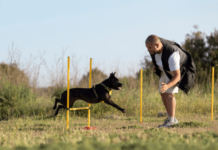Last Updated on January 26, 2022 by Dogs Vets
How to Escape and Evade Tracking Dogs
What is a Tracking Dog?
Tracking Dogs were first used in the 12th century by the Knights Templar, but have evolved from hunting animals to keeping people safe.
Tracking dogs are specially trained to find people and objects. They have a unique scent that, when following, can take them straight to the person or object.
Why are Tracking Dog Used?
The use of tracking dogs is one of the most useful tools in law enforcement. They are highly trained to detect everything from explosives to drugs and guns. In addition, they can distinguish between human and animal scents and locate people, especially those who are lost or missing.
There are many ways to escape and evade tracking dogs. All of these methods can be used to escape from a dog, but they are not all foolproof.
There are many ways to evade and escape tracking dogs. Some of them are listed below:
- – Running away
- – Walking on the side of the road, on a bicycle, or in a vehicle
- – Hiding in tall grass or bushes
- – Jumping into a body of water and swimming away
Basic Tips on Evading a Dog in the Wild without Stopping or Making a Lot of Noise.
Tracking dogs are trained to find people and their scents. They are also used by law enforcement agencies to track down criminals.
With their help, the police can find lost or stolen property, as well as evidence at a crime scene.
There is no foolproof way of escaping a tracking dog, but there are some techniques that you can use to evade them and make them lose your scent.
Some techniques that you can use to evade tracking dogs include:
– Moving your body in different directions
– Walking through mud or water
– Wearing a mask or disguise
Dog Versus Human Trackers
It is a common belief that dogs are better than humans at tracking. But this is not true because they are not able to plan ahead and think strategically.
On the other hand, human trackers can be more strategic because they have to consider factors such as terrain, weather, and time of day. They also have to take into account the actions of their dog or other things that may be out there in the environment.
How Do Dog Trackers Work?
Dogs are a good way to find people. They have an amazing sense of smell and can track any scent that is left behind by their human companion.
Dogs have been used for centuries to track criminals, lost people, and missing animals.
The idea of using dogs to track people is not new either. It was first introduced in the United Kingdom during the late 1800s when police officers were trying to find escaped prisoners who had managed to escape from prison on foot.
Dogs are also used in search-and-rescue operations because they can sniff out survivors buried under rubble or locate people trapped in collapsed buildings or caves.
Does the Proximity of the Animal Matter in Tracking?
The proximity of the animal is an important factor in tracking. The closer the animal is, the more chances that it will detect you.
The proximity detector is a sensor that measures the distance to a target. It can be used in many different fields like military, hunting and wildlife management.
The use cases of this sensor are varied with some being for security purposes and others for research purposes.
The Mistakes Made by Tracker Dogs
Tracker dogs are trained to track people and animals. They are often used in search and rescue missions. However, they have also been used to find lost children, missing hikers, and even as a means of catching criminals.
These dogs are highly trained for their tasks but unfortunately, there is no perfect tracker dog. A tracker dog can make mistakes like any other animal or human being.
In fact, some dogs make so many mistakes that it is almost impossible to list them all out.
This article will list out all the mistakes that Tracker Dogs have made in the past few decades and will conclude with what we can do to prevent these issues from occurring again in the future.
How to Avoid a Tracking Dog on the Street
It is always a good idea to cross the street quickly when you see a tracking dog. You should also try to use blind spots or cross streets quickly.
It is important to keep your eyes on the ground and be aware of your surroundings.
It is always a good idea to cross the street quickly when you see a tracking dog, but it can be more difficult if you are in an area with many people and buildings. Try not to look at the dog’s handler, but instead focus on your surroundings and keep looking down at the ground.
How to Evade a Tracking Dog on the Street
There are a few ways to evade a tracking dog. You can use trees, bushes, trash cans, and other objects to become invisible. If you are in a car, you can speed away or switch lanes. If you have a bicycle with you, then you can quickly pedal away from your tracker.
If your tracker is close by and there is no way for you to escape him/her then you should make as much noise as possible. This will make it difficult for the tracker to keep track of your location and find you again.
What are the Best Ways to Defend Against Tracking Dogs?
There are many ways to defend against tracking dogs, but some of the best ways to do so include:
- Keeping your dog on a leash when you go out
- Using a bell on your dog’s collar when you come home
- Not leaving food and water out for your dog
- Taking care of any garbage that is left outside
- Making sure that there is no food or water available for the dog to find in your yard or house
How to Make Tracks a Dog Can’t Follow
In order to escape a tracking dog, you have to use evasion techniques. There are different evasion techniques that can be used depending on the situation.
There are two types of evasion techniques:
– Physical evasion:
There are two types of evasion techniques. The first includes physical evasion techniques such as hiding and running. The second includes behavioural techniques such as lying and falsifying records.
– Psychological evasion:
In psychology, evasion is the act of concealing or withholding information or feelings.
Tricks will not assist you in locating tracking dogs
To avoid being detected by a trained dog team by doubling back, creating a triangle of scents (a method some belief can work), or spraying the ground and your feet with pepper spray, the best thing you can do initially is get as far away from the dog team as you possibly can as quickly as you possibly can, traveling through difficult terrain.
Then keep moving, hoping to exhaust both dogs and handlers so that they give up the search as soon as possible.
The first order of business is to escape as far away from your pursuers as you possibly can. You can save the techniques for later if the pursuit is still going on and you aren’t losing sight of your pursuers.
There is no doubt that radio communications, particularly tracking from the air, must be taken into consideration. So:
Do not ignite any campfires since they emit a heat signature that can be detected and tracked by a heat detector from a plane flying overhead.
It is not recommended that you flee in the direction of a road that links with the location you are escaping.
If you need to evacuate, do not go to a second populated area or town unless it is a safe place to do so. (Keep in mind that radio communications to a patrol or outpost near that town could imply that a patrol will begin searching for you from that direction, and thus even if you or others believe it is safe to leave to, it may not actually be safe to do so.
Tracking dogs can be frightened away with pepper spray.
Some online sources claim that pepper spray or pepper (either black or red chili pepper) can aid in evading a tracking dog’s attention.
Is this true? On the surface, the concept is that you spray or scatter pepper on your tracks and that this will cause the dog to lose track of where he is.
It’s been said so many times that it’s become something of an urban legend in some circles. It is important for you to understand that this is not true.
Even if they come across the pepper after picking up your scent, modern tracking dogs have highly sensitive noses and will easily pick up your scent again shortly after. They will not be able to get rid of the aroma.
Having said that, this strategy can only buy you a few minutes of time at most. The pepper may cause the tracking dog to become distracted or disturbed, allowing you to gain 2-5 minutes of additional time to get further away.
As a result, if your pursuers are closing in on you, it might make sense to employ this strategy.
Lastly, bear in mind that pepper spray is frequently effective in dealing with human attackers as well, so while it may not work to disorient the dog, it may be the last alternative for defending yourself against the dog’s human handlers.
So it’s not a bad idea to keep a pepper spray canister on hand just in case something happens.
We recommend bear pepper spray because it is the most powerful type of pepper spray that is commonly accessible, and if it can incapacitate a bear, it will almost certainly incapacitate a dog (or its handlers) as well.
What the Mythbusters had to say about attempting to escape tracking dogs.
A common tactic to lose a trained tracking dog (they used a bloodhound and its handler) was proven almost impossible by Mythbusters in episode 148 Hair of the Dog, though they did conclude that it was plausible to use a populated area with its abundance of scents and distractions to help confuse a tracking dog and make a successful escape in the episode.
As a result, escaping into a populated place may be a viable option for evading a tracking dog.
This method has the potential to overwhelm a dog’s senses — it’s similar to putting an incredibly bright light directly into a person’s eyes, causing them to be unable to perceive anything. Getting away into inhabited regions, on the other hand, comes with its own set of risks and perils.
A crowded location does not necessarily indicate a small town; rather, you desire a high-density area, which means you are looking for an urban area with as much foot traffic as feasible (this may require some knowledge of urban survival).
If you don’t flee to a high-density population region, a tracking squad is likely to follow you down, according to Mythbusters.
Once again, it boils down to the continual trail of skin cells that we leave behind us wherever we travel.
Tips From A Professional Tracker Dog Handlers
When asked if it is conceivable for a tracking dog and its handler to become separated, Ed Frawley, who is a well-known law enforcement tracking dog trainer and owner of one of the most prestigious German Shepherd breeding facilities in North America, as well as an experienced tracker, says it is.
When it comes to a basic patrol dog, it turns out that these dogs do not normally have a high success rate when it comes to tracking down and apprehending a fleeing perpetrator. In fact, when “local dogs” are summoned, they have a tendency to lose their track more quickly and to exhaust more quickly.
This, of course, works to your advantage, as long as you continue to move in the right direction. The reason behind this is as follows:
“Once the local dogs have lost their track or become fatigued, an advanced handler with a superior canine with advanced training can be summoned, but he or she may have to travel from 100 to 200 miles distant to assist.
In order to get to where your escape path begins, this expert tracker must travel from out of town, which means that while you have several hours of lead time, you are still at risk of being overtaken.
What About Military Tracking Dogs, Do They Exist?
Military tracking dogs are increasingly being trained and employed to identify mines, booby traps, and snipers in close proximity. As a result, there are fewer canine teams that are properly trained to trace a fleeing suspect through a wilderness setting.
On the other flip side of the coin, if you were good enough and had a rifle, and you circled around on an approaching military canine team, they are more likely to see you because these dogs are trained to find concealing snipers.
This is most likely not a good idea. (Unless you are not alone and there’s more than one of you, or you’ve got a chokepoint set and waiting for you that you’ve already planned for.)
Sentry Dogs are a sixth option.
These are highly trained dogs that are used to protect the perimeters of military facilities and camps.
When an intruder or intruders are discovered, armed personnel are dispatched to the immediate area to deal with the situation.
Patrol dogs that are trained to look for resistance fighters or refugees.
It is one thing to call in a tracking team and go after someone who has been suspected of fleeing; it is quite another to bring in tracking teams with the express intention of locating and rooting out escapees and perhaps resistance fighters in a certain area.
In the case of a map, trained personnel have the ability to circle an area where they suspect people are hiding, and then they can come in from multiple directions to round up anyone who has been caught inside the search area.
Refugees during a war, for example, or individuals fleeing from martial law are examples of such situations.
A prolonged period of time spent in one spot, particularly within the range of a military station or outpost, increases the likelihood that your location may be discovered during a patrol or search.
Questions People have also inquired.
How far can a dog police dog track a person?
How far can a dog follow a human? A trained dog can detect a scent between fifty and five hundred yards away, depending on the weather.
However, if the weather is particularly poor, a hundred yards may be excessive. A dog standing upwind on a windy day can definitely smell a person forty yards away.
What causes a dog’s sense of smell to be impaired?
One aroma that can fully overwhelm a dog’s sense of smell is bleach, which can cause them to lose their ability to smell completely.
As a result, they are unable to process other scents in their environment. Despite the fact that they have lost their sense of smell, which was their primary sense, they continue to rely on it for survival.
Is it possible to conceal your scent from a dog?
Every second, millions of minute skin cells are shed by animals, and dogs can detect these cells and use the information they gather to form a mental image of their surroundings based on smell.
You cannot entirely hide your human fragrance unless you are enclosed in a bubble that has no openings or vents. This is impossible unless you are in a completely sealed bubble.
What is the effect of red pepper on police dogs?
According to a veterinarian consulted for the investigation, inhaling cayenne pepper can result in medical emergencies in animals, ranging from irritation and burning of the mucous membranes of the nose and throat passageways to respiratory distress, which can result in “embolism, respiratory arrest, or death.”
How do police dogs identify who to pursue?
They have been taught to follow the most potent scent. As long as they are tracking the same scent, they will eventually find its source. The dog will follow the scent trail as long as no one else has crossed it since the perpetrator left.
How do dogs react when they sniff black pepper?
When used in large quantities, black pepper is spicy—a flavour that the majority of dogs dislike. If your dog inhales black pepper (for example, if it spills into the floor), it may induce an extremely unpleasant sensation in his nose, causing him to sneeze incessantly.
Can dogs easily smell through black pepper?
Fortunately, most dogs are naturally averse to the potential health risks associated with black pepper due to its pungent aroma. It is extremely annoying to a dog’s sense of smell, and the majority of dogs will avoid eating it or simply being near it. Indeed, black pepper has been used to deter dogs from chewing.
Is it true that police dogs are trained to bite?
Once located, they are taught to bark in order to signal that they have spotted the perpetrator. There are some circumstances in which a dog may bite an officer, such as when the officer is chasing a suspect and does not stop because the dog cannot distinguish between a running suspect and a running police officer.”
Conclusion:
We hope you enjoyed this article…How to Escape and Evade Tracking Dogs
Please feel free to share with us in the comments section below.

















